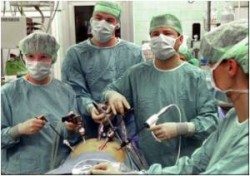Surgical Solutions to
an Enlarged Prostate
 There are only a few reasons why a man who is dealing with symptoms of benign prostatic hyperplasia or BPH would require surgery.
There are only a few reasons why a man who is dealing with symptoms of benign prostatic hyperplasia or BPH would require surgery.
These include:
1. The inability to urinate at all. Approximately 50% of the men who are unable to urinate will require catheterization. This is where a tube is inserted into the urethra and then into the bladder. The urine is drained through this tube. About 50% of the men who get catheters will regain the ability to urinate. The other 50% might have to undergo a surgical procedure.
2. An obstruction in the urethra that is triggering chronic urinary tract infections, damage to the bladder, or bladder stones.
3. The presence of blood in the urine that is not improving.
4. Damage to the kidneys.
Even if you do not have any of the above conditions that require surgery, you still might elect to have a surgical procedure because the symptoms are particularly uncomfortable or other remedies have proven to be ineffective. You need to think about:
1. Whether or not you think the surgical procedure will help with the symptoms.
2. The severity of the symptoms.
3. The risk of surgical complications.
Surgical Options
The most prevalent forms of surgery used to treat BPH are minimally invasive. Special surgical tools are threaded through the urethra to the prostate. These are called transurethral surgical procedures.
The procedure that is used most often is called transurethral resection of the prostate or TURP. With this procedure, a portion of the prostate is excised.
There are other surgical procedures that are used less often than TURP. These are:
1. Transurethral incision of the prostate or TUIP. With this procedure, the prostate is cut to relieve the pressure it is putting on the urethra.
2. Transurethral laser coagulation or transurethral laser vaporization. With this procedure, a laser is utilized to cut into a part of the prostate, again to relieve the pressure.
3. Transurethral microwave therapy or TUMT. With this procedure, microwaves are used to destroy some prostate tissue by heating it up.
4. Transurethral needle ablation or TUNA. With this procedure, a needle is heated up and is used to destroy some prostate tissue.
For the most part, these surgical procedures have only been around for several years, which means, it is unknown how they affect the prostate years down the road.
In a certain small number of instances of enlarged prostate, the traditional surgical procedure is implemented to remedy BPH. This is called an open prostatectomy. A surgeon makes a cut into the skin to access the prostate. This is usually only done when the prostate is extremely oversized.
Considerations
Out of all the enlarged prostate remedies available, surgery is the one that has the best results. However, some symptoms may still exist. In addition, patients are exposed to a higher risk of complications such as impotence, incontinence, and retrograde ejaculation where the semen goes into the bladder rather than out of the penis.
Males who suffer greatly from BPH symptoms usually receive instant relief after surgery. Males whose symptoms are relatively minor could discover that surgery is not as effective as they had hoped. For men with minor symptoms, it is worth considering this outcome prior to undergoing surgery.
In the event that a man has elected to undergo surgery, or if a physician has recommended surgery, he will need to decide on the kind of surgery to have based on how large his prostate is, the shape of the prostate, and how much experience the physician has with the particular kind of surgery. Of the two main surgeries, TURP is the most prevalent kind, while TUIP is recommended for men whose prostates are still rather small. This last procedure does not present as many risks as TURP and males will recover faster as well. The outcomes of the two procedures are very similar.